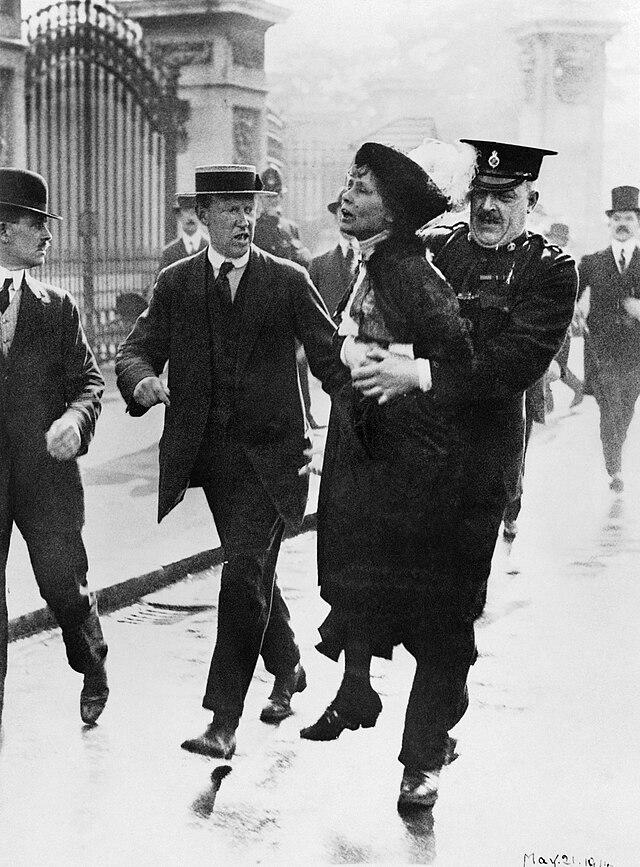Throughout history, women who stand outside of the expectations of their respective societies tend to be physically perceived negatively. These women, for example, have been described as ugly, repellent, vile, nasty, and evil. However, the adjectives used were not based on their physical appearances but created in regard to their beliefs and personalities. The concept of femininity is usually paired with traits such as gentleness, innocence, warmth, and sweetness. Throughout time, many societies have both celebrated and enforced patriarchal ideas and the concept of feminine submission. Different cultural practices portray the enforcement of these constraints and the strive for women to have small, dainty features. Notable examples include the Chinese exercise of foot binding between the 10th to 20th centuries and the French - soon followed by numerous other European nations - practice of corset-wearing. A woman’s worth has mainly been defined by her beauty and ability to meet societal expectations. So, when women stray from the cultural ideologies of their place in society, there is no better way to discredit them than by attacking their physical appearance.
Let’s do a little exercise. If I mention the word “witch” to you, what physical traits and adjectives come to mind? Have you considered qualities such as a large, hooked, crooked, or bumpy nose? Warts? Wrinkles? In mainstream media, witches have been widely portrayed as ugly, evil, old, mean, and vile hags. However, the official definition of a witch is “a person (especially a woman) who is credited with having usually malignant supernatural powers. (Merriam-Webster Dictionary)” So how did these fictional characters become associated with these unattractive qualities? The history of these fictional women and the evolution of their definition in the 21st century is a long and complicated story. In relation to the topic of standing outside of societal expectations, we are going to examine the physical traits of a witch in terms of the witch trials. The accusation of the use of witchcraft by women began in the 15th century in Europe and continued for around 300 more years. These proceedings eventually transferred over to Puritan New England in the Americas during the Age of Colonialism in the early 1600s. These European trials set precedence for the widely recognized Salem Witch Trials of 1692. In both Europe and America, the women accused were usually either widowed, unmarried, independent or generally strayed from the typical ideals of femininity of the era. These women were used as scapegoats to explain catastrophes of the time that typically included famines, natural disasters, or political issues. The women labeled as witches were perceived physically in a negative light and adjectives to describe a witch- as we know them today- began to circulate. Not only were these derogatory adjectives used to inspire fear of the power that unmanaged women could hold but also justified the killing of these women without solid proof they committed witchcraft.
Another prime example of this historical continuity includes the perception of suffragettes during the fight for women’s right to vote. The term refers to women, specifically in the United Kingdom, who used more aggressive tactics to gain their voting right. In the Victorian Era, British women had no legal presence. Unlike their male counterparts, they had no right to possessions or property. They couldn’t claim any earnings from jobs, as they weren’t legally entitled to them in the first place, subjecting to exploitation - a feature Victorian England is quite known for. They could not sign any documents, including leases or contracts, and even their will was not legally legitimate. Additionally, even though men could divorce, women would legally remain married to the man but cut off completely from any support without a right to alimony. When it actually came to legal proceedings, they weren’t allowed to speak up or be represented (by a lawyer) in court, if they were lucky enough to enter.
Naturally, the women were fed up. Their hopes of being supported by their female (and at the time very progressive) queen were crushed and their demands were ignored. Although violence had been on the rise, the ultimate death of a suffragette caused by a carriage running her over triggered major uprisings that were addressed by society through papers and discussion. They broke through the wall of the so-called “Victorian Compromise” (problems are not actually addressed, but instead ignored and swept under the rug). In 1903, Emmeline Pankhurst (1858-1928) founded the WSPU - the Women’s Social and Political Union after being an active member in protests since 1880. Under Emmeline’s leadership, the WSPU was a highly organized group, willing to go on hunger strikes and even be imprisoned. Besides those, their methods ranged from art and debate to public disobedience, vandalism and even arson. Ultimately, the organization was disbanded in 1918, but its principles continue to have their influence to this day.
These women stood far from Great Britain's traditional definition of a women's role in society. To discredit them and mock their efforts, they were portrayed as unattractive and unwanted, often using the narrative that no man wanted to marry them. Newspaper cartoons portrayed these women to have traits that went against the beauty standard, including big lumpy noses, and red faces, but also rude, annoying, and especially sexist behavior towards men, which of course we know wasn’t true. To continue this hostile nature towards suffragettes, jokes regarding their appearance were typically enforced to mock their goals and maintain public support for their ostracism.
The patriarchy has continued to enforce the idea that a woman's worth is based on her beauty and her primary purpose is to reproduce and serve the man of the house. Therefore, the portrayal of women who stand outside of their societal expectations as ugly has been very damaging to numerous women around the world. And although in the 21st century, women have continued to fight for their rights and take back the patriarchal definition of feminine beauty, we are still a long way from ridding these ideas.
